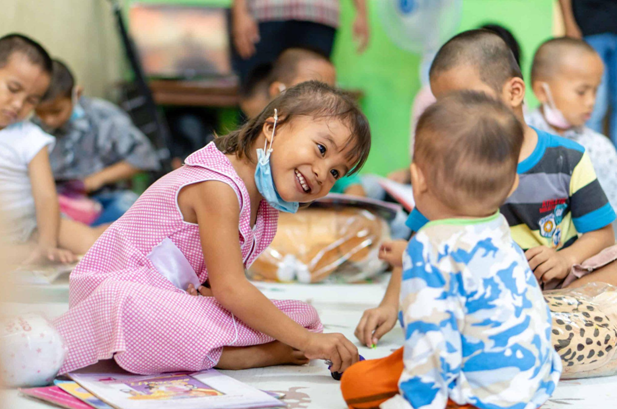It’s no secret that kids today are spending less time outdoors than ever before. Parks and playgrounds are quieter, while screens glow brighter in living rooms and classrooms alike. Research shows the average child spends more than six hours a day on gadgets, but less than one hour outside. For parents and educators, this raises an important question: what...
The Importance of Social Interaction for Holistic Growth in the Digital Age
Redefining Social Interaction in the Digital Era
Today’s children are growing up in a world where digital screens often replace playgrounds and emojis replace expressions.
While technology has its benefits, like access to learning tools, global exposure, and creative platforms, it has also quietly reduced the quality of real, face-to-face interactions.
And here’s the truth: No app can replicate the human connection that shapes a child’s growth. That’s why understanding the importance of social interaction in child development has become more vital than ever in this digital age.
Understanding Holistic Development in Early Childhood
Holistic development goes beyond academics; it’s about nurturing the whole child through mind, body, and emotions.
From communication and empathy to coordination and confidence, every area of development is influenced by how children connect and interact with others.
When children engage socially, whether by playing with peers, sharing stories, or collaborating in class, they are building the very foundations of emotional intelligence, creativity, and self-awareness.
The Digital Age Dilemma: Screen Time vs. Face Time
Screens are now woven into everyday routines. But while digital exposure has become inevitable, excessive screen time can limit real-world interaction, which is crucial for developing empathy, language, and confidence.
Research insight:
According to the American Academy of Pediatrics, children who spend more time engaging in real-world play demonstrate higher cognitive flexibility, better emotional regulation, and stronger problem-solving skills.
It’s not about eliminating screens; it’s about balancing screen time with face time. Read about the impact of excessive screen time on fine motor skills.

Why Social Interaction Is the Foundation of Holistic Growth
1. Cognitive Development Benefits
When children engage in conversations, group games, or storytelling, they learn to listen, process, and respond, essential skills for brain growth.
Social play stimulates memory, attention, and reasoning, which directly support academic learning. Explore more about how cognitive development is shaped in early years.
2. Emotional Intelligence Building
Interacting with peers teaches children to identify emotions, express feelings appropriately, and develop empathy.
When they learn to say “I’m sorry” or “It’s okay,” they’re actually practicing emotional regulation, a skill that supports lifelong well-being. Learn about the importance of empathy in child development.
3. Physical Development Connection
Yes, social interaction even impacts physical growth.
Activities like cooperative play, dance, or outdoor sports build motor skills, balance, and coordination while also fostering teamwork. Read how play-based learning strengthens physical and creative growth.
4. Social Skills Mastery
Sharing, waiting for turns, and cooperating are social skills that don’t develop in isolation.
They’re learned through real interactions where children observe, imitate, and adjust behaviors based on social feedback. Try these social skills games for children to encourage cooperation and communication.
Age-Specific Social Interaction Needs
Toddlers (1 to 3 years):
Parallel play, where children play side by side, helps them observe and learn from others.
Preschoolers (3 to 5 years):
They begin to engage in cooperative play, understanding sharing, empathy, and teamwork.
School-age children (6 to 10 years):
At this stage, friendships deepen. Group projects, problem-solving, and communication take center stage.
As children grow, consistent exposure to social environments helps them build resilience and adaptability that last a lifetime.
The Tickle Right Approach to Balanced Development
At Tickle Right, we believe that learning isn’t just about what happens inside the classroom; it’s also about what happens between children.
Our holistic brain development program integrates social, emotional, and cognitive learning, ensuring children grow with balance and joy.
What Makes Tickle Right Different
Right Brain and Left Brain Integration: Activities designed to strengthen both creative and analytical thinking.
Interactive Sessions: Small group formats that encourage teamwork and communication.
Emotional Intelligence Training: Exercises that promote empathy, patience, and collaboration.
Parent Involvement: Regular feedback sessions that help parents continue the learning at home.
By blending learning with interaction, Tickle Right ensures children don’t just become smarter; they become socially and emotionally strong.
Practical Strategies for Parents: Fostering Social Skills at Home
Parents play a powerful role in shaping social intelligence. Here’s how you can help:
- Encourage playdates and group activities. Even small interactions can teach big lessons in sharing and teamwork.
- Model empathy. Children learn how to treat others by watching how we respond to people and situations.
- Create family discussion time. Mealtime or bedtime chats help children express thoughts freely.
- Limit screens consciously. Set daily screen boundaries and replace that time with creative or physical play.
- Enroll in group-based programs like Tickle Right’s interactive classes, where structured social play is woven into learning.
The Long-Term Impact: Setting the Foundation for Future Success
Children who develop strong social connections early on tend to have better emotional balance, problem-solving abilities, and confidence as adults.
Social skills are lifelong assets, enabling individuals to navigate relationships, teamwork, and future workplaces with ease.
In short, the conversations and laughter shared in childhood are the building blocks of emotional intelligence in adulthood.
Conclusion
The digital age offers convenience, but connection is what truly nurtures growth.
By giving children more opportunities to play, talk, share, and listen, we help them grow into emotionally intelligent, confident, and well-rounded individuals.
At Tickle Right, we continue to create spaces where children can learn through connection because social interaction isn’t just part of growth, it’s the heart of it.
FAQ: Parent Questions Answered
Q: Is my child getting enough social interaction?
If your child regularly engages with peers through school, playdates, or structured programs, they’re likely getting enough. Look for signs like improved communication, empathy, and confidence.
Q: How do I balance screen time with social time?
Follow the 3:1 rule. For every one hour of screen time, ensure three hours of active play, outdoor time, or social interaction. Learn more about screen time balance and motor development.
Q: What if my child is shy or introverted?
Shyness isn’t a weakness. Start small, pair them with one friendly peer, and gradually introduce group settings. Encourage, but don’t force interaction. Try gentle social skills games to ease them in.
Q: Can online interactions substitute for in-person play?
While online communication can help with connection, it lacks physical cues and empathy-building elements. Real-world play like storytelling and group games remains irreplaceable for emotional and social development.

